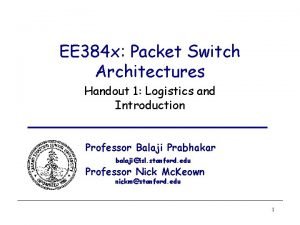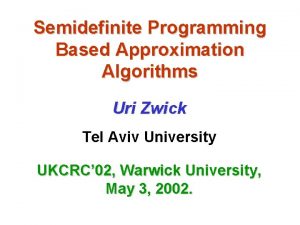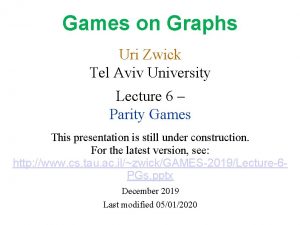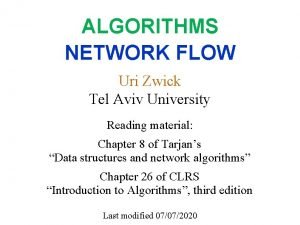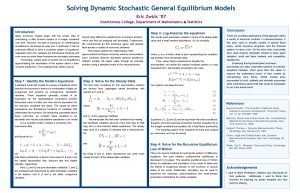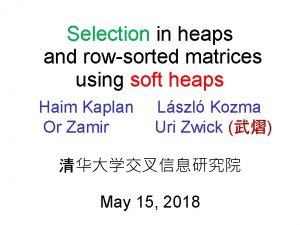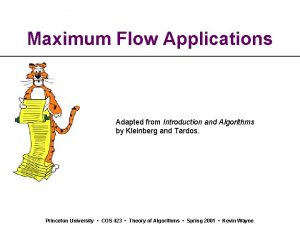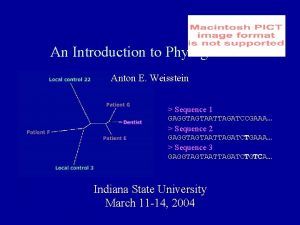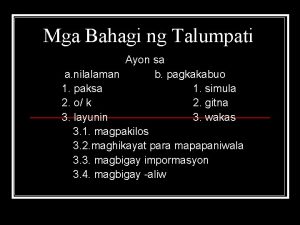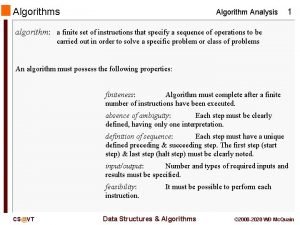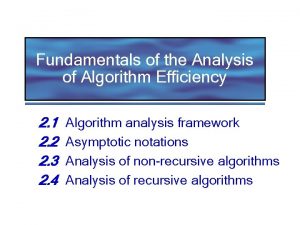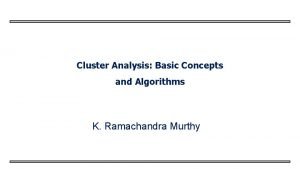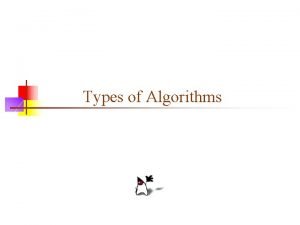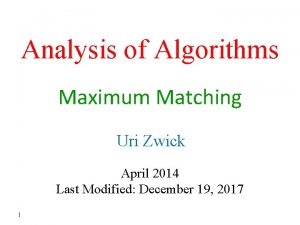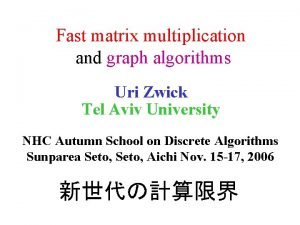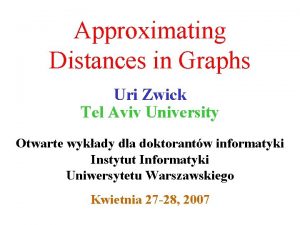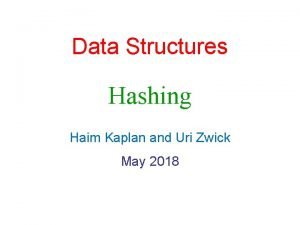Analysis of Algorithms Maximum weight matching Uri Zwick






























![Linear Programming formulation of the general weighted matching problem [Edmonds (1965)] (P) has Linear Programming formulation of the general weighted matching problem [Edmonds (1965)] (P) has](https://slidetodoc.com/presentation_image_h/96806a83a3fc144d7777225c24a4eaf5/image-31.jpg)
![Linear Programming formulation of the general weighted matching problem [Edmonds (1965)] Correctness of Linear Programming formulation of the general weighted matching problem [Edmonds (1965)] Correctness of](https://slidetodoc.com/presentation_image_h/96806a83a3fc144d7777225c24a4eaf5/image-32.jpg)















- Slides: 47

Analysis of Algorithms Maximum weight matching Uri Zwick May 2014 Last modified: January 1, 2018 1

Maximum Weight Matching Find a matching whose total weight is maximal. 3 8 15 22 6 4 18 1 5 25 2 Maximum weight matching 2

Maximum Weight Matching Find a matching whose total weight is maximal. 3 8 15 22 6 4 18 1 5 25 2 3 An augmenting path that increases the size of the matching, but not the total weight of the matching.

Maximum Weight Matching The maximum matching problem in bipartite graphs can be easily reduced to a min cost flow problem. The problem in non-bipartite graphs is harder. First polynomial time algorithm given by [Edmonds (1965)]. 4

Alternating paths and cycles + − + + −

Improving paths or cycles Proof:

Maximum weight augmenting paths Proof:

The assignment problem The maximum weight matching problem in bipartite graphs is also known as the assignment problem. Possible application: Assigning people to tasks. Each person can only perform a single task. Each task can only be performed by a single person. The “Hungarian method” [Kuhn (1955)] [Jacobi (1865)? ] We shall derive it in two different ways.

Algorithm for the assignment problem Return the maximum weight matching found. How do we find maximum weight augmenting paths? In bipartite graphs, can be reduced to computing a shortest path.

Finding maximum weight augmenting paths in bipartite graphs Negate the weights of the edges not in the matching Such a shortest path is a maximum weight augmenting path

Finding maximum weight augmenting paths in bipartite graphs Slow!

Modified costs

Finding augmenting paths

Finding augmenting paths

Linear Programming duality

Weak duality

Complementary slackness

Linear Programming formulation of the assignment problem Is this really a valid formulation? Who says that (P) has an integral optimal solution?

Linear Programming formulation of the assignment problem Three different ways of showing that the formulation is valid: 3) Our algorithm will always find an integral optimal solution.

Direct proof There is either a path of fractional edges between two unsaturated vertices, or an even cycle of fractional edges.

Incidence matrix of a (bipartite) graph Edges 1 1 Vertices Every column contains exactly two 1 s The incidence matrix of a bipartite graph is totally unimodular, i. e. , the determinant of every square submatrix is 1, 0 or +1.

The primal-dual method (a. k. a the “Hungarian method”)

The primal-dual method Preliminaries Start with:

The primal-dual method Keep the dual values of all vertices. What do we do if we are “stuck”? (The forest cannot be extended using tight edges and the dual variables of some unmatched vertices are still positive. )

Adjusting dual variables All edges leaving the forest, from even vertices, are not tight. Slacks of edges connecting two vertices in the forest are unchanged. All forest edges and matched edges are still tight.

Adjusting dual variables All edges leaving the forest, from even vertices, are not tight. Exercise: Are the augmenting paths found by the algorithm of maximum weight?

Linear Programming formulation of Single Source Shortest Paths (P ) (D ) The primal expresses the SSSP problem as a min cost flow problem. The dual variables are distances. (The dual is a maximization problem. ) Complementary slackness conditions:

Single Source Shortest Paths as a Min Cost Flow problem

Primal-Dual algorithm for SSSP (non-negative edge weights) Maintain complementary slackness: Satisfy more and more primal constraint until the primal solution is feasible and hence also optimal. Start with:

Primal-Dual algorithm for SSSP (non-negative edge weights) Grow step Dual adjustment step If there are no tight edges leaving the tree: Looks familiar? Dijkstra!
![Linear Programming formulation of the general weighted matching problem Edmonds 1965 P has Linear Programming formulation of the general weighted matching problem [Edmonds (1965)] (P) has](https://slidetodoc.com/presentation_image_h/96806a83a3fc144d7777225c24a4eaf5/image-31.jpg)
Linear Programming formulation of the general weighted matching problem [Edmonds (1965)] (P) has an exponential number of constraints. (D) has an exponential number of variables.
![Linear Programming formulation of the general weighted matching problem Edmonds 1965 Correctness of Linear Programming formulation of the general weighted matching problem [Edmonds (1965)] Correctness of](https://slidetodoc.com/presentation_image_h/96806a83a3fc144d7777225c24a4eaf5/image-32.jpg)
Linear Programming formulation of the general weighted matching problem [Edmonds (1965)] Correctness of formulation would follow from algorithm. Note the similarity of dual with odd vertex cover.

The Primal-dual method The non-bipartite case Primal solution: Dual solution:

The Primal-dual method The non-bipartite case Primal solution: Dual solution: Complementary slackness conditions: The algorithm maintain (1) and (3). Makes progress towards (2).

Correctness If the algorithm terminates, correctness follows from weak duality. Or directly:

More fun with blossoms In the cardinality case, after each augmentation we expanded all blossoms and started from scratch. We cannot do it here, as blossoms now have dual values. Lemma: A blossom remains a blossom after an augmentation, possibly with no stem. We thus start each phase with a collection of blossoms. During a phase, new blossoms may be formed, and existing blossoms may be expanded. In the cardinality case, blossoms were always even. Blossoms may now be added as odd vertices.

The effect of an augmentation on a blossom

The alternating forest All vertices are blossoms. (Some nested, some trivial. ) All edges in the forest are tight. All edges in blossoms are tight, even if they are not in the forest. When there are no more tight edges to explore, adjust dual variables.

The Primal-dual method Initialization Start with:

Adjusting dual variables All edges leaving the forest, from even vertices, are not tight.

Changes in slacks

All complementary slackness conditions are satisfied. We are done! After the update, at least one more edge leaving the forest from an even vertex is tight. We can extend the forest while keeping all invariants.

An edge connecting two even vertices in different blossoms becomes tight. If the blossoms are in different trees augmenting path The new even blossom swallows some odd blossoms. All vertices in these blossoms become even and tight edges leaving them may be explored.

New even blossom These blossoms leave the forest

Number of steps Does the algorithm terminate? After each adjustment of the dual variables, either we are done, or an augmenting path is found, or the number of even vertices increases. Algorithm is polynomial! [Edmonds (1965)]

Number of even vertices increases After each adjustment of the dual variables, either we are done, or an augmenting path is found, or the number of even vertices increases. Case 1: We are done. Case 2: The forest is extended. The new odd blossom added is either unmatched (an augmenting path found), or an even blossom is immediately added. Case 3: Either an augmenting path is found or a new blossom is formed. The new blossom swallows some odd vertices that are now even. Case 4: An odd blossom is expanded. Some of its vertices become even.

Efficient implementation Maintaining blossoms and finding augmenting paths Similar to the unweighted case, though now we also have to expand blossoms. Using some (sophisticated) data structures we can implement each phase in:
 384 x 1/2
384 x 1/2 Maximum weight matching
Maximum weight matching Tbsgs
Tbsgs Max cut
Max cut Uri zwick
Uri zwick Uri zwick
Uri zwick Net flow
Net flow Eric zwick
Eric zwick Soft heaps of kaplan and zwick uses
Soft heaps of kaplan and zwick uses Maximum cardinality matching
Maximum cardinality matching Hungarian maximum matching algorithm
Hungarian maximum matching algorithm Absolute max
Absolute max Maximum parsimony vs maximum likelihood
Maximum parsimony vs maximum likelihood Maximum likelihood vs maximum parsimony
Maximum likelihood vs maximum parsimony Airport characteristics related to airport design
Airport characteristics related to airport design Tulloch brown traction
Tulloch brown traction Tolerable weight is a body weight
Tolerable weight is a body weight Bulk reducing industry
Bulk reducing industry Halimbawa ng talumpati ayon sa layunin
Halimbawa ng talumpati ayon sa layunin Ano ang pang uri
Ano ang pang uri Halimbawa ng pang uri na pangungusap
Halimbawa ng pang uri na pangungusap 1001 design
1001 design Algorithm analysis examples
Algorithm analysis examples Analysis of algorithms
Analysis of algorithms Association analysis: basic concepts and algorithms
Association analysis: basic concepts and algorithms Output
Output Algorithm analysis examples
Algorithm analysis examples Analysis of algorithms
Analysis of algorithms Fundamentals of the analysis of algorithm efficiency
Fundamentals of the analysis of algorithm efficiency Cluster analysis basic concepts and algorithms
Cluster analysis basic concepts and algorithms Probabilistic analysis and randomized algorithms
Probabilistic analysis and randomized algorithms Introduction of design and analysis of algorithms
Introduction of design and analysis of algorithms Analysis of algorithms lecture notes
Analysis of algorithms lecture notes Cluster analysis basic concepts and algorithms
Cluster analysis basic concepts and algorithms Cjih
Cjih Goals of analysis of algorithms
Goals of analysis of algorithms Exercise 24
Exercise 24 Binary search in design and analysis of algorithms
Binary search in design and analysis of algorithms Introduction to the design and analysis of algorithms
Introduction to the design and analysis of algorithms Competitive analysis algorithms
Competitive analysis algorithms Design and analysis of algorithms
Design and analysis of algorithms Design and analysis of algorithms
Design and analysis of algorithms Cluster analysis basic concepts and algorithms
Cluster analysis basic concepts and algorithms Design and analysis of algorithms
Design and analysis of algorithms How to determine drip rate
How to determine drip rate Western aphasia battery
Western aphasia battery Computational thinking algorithms and programming
Computational thinking algorithms and programming Types of algorithm
Types of algorithm
